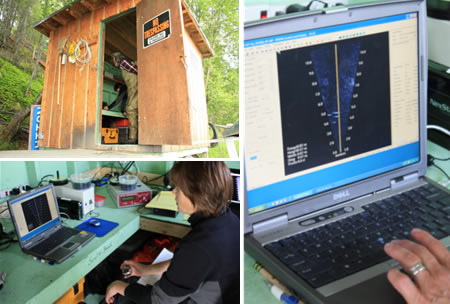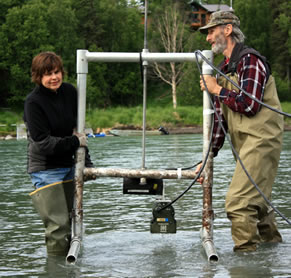
Kenai (RM 19) River
Sonar Tools
Sonar Tools

At the Kenai River sonar site, the Alaska Department of Fish and Game detects fish using a type of sonar technology known as DIDSON. ADF&G has been using sonar to monitor salmon in the Kenai River since 1968, but has only been using DIDSON for generating escapement estimates since 2008. Before DIDSON the site used a type of sonar known as Bendix. The site used DIDSON and Bendix side-by-side for four years before completely transitioning to DIDSON to generate estimate data in 2008 (see comparison study).
The detection ranges of the site's shore-based DIDSON transducers do not cover the entire 390-foot width of the river channel. Along the north shore, the DIDSON detection range extends out to about 98 feet from shore. Along the south bank, the DIDSON detection range extends out to about 66 feet from shore. While DIDSON detection ranges do not cover the middle of the river, biologists do not worry about missing fish there. When river currents are swift as they are at the Kenai River Mile 19 sonar site, sockeye salmon conserve energy by migrating close to shore where currents are slower (see reference to study examining migrating salmon energy-conserving behavior). At the Kenai River Mile 19 sonar site most sockeye salmon migrate within just 16 feet of shore.
At most sonar sites in Alaska, ADF&G biologists use sonar to sample over time rather than run sonar continually. At the Kenai River, technicians record 10-minute sonar snapshots each hour along each bank, expand the counts to hourly estimates and then sum the hourly estimates to produce a full 24-hour estimate. Research has found the difference in estimates generated while running sonar continually and estimates generated while sampling is very small. But the difference in operational costs is huge (see sampling methods study).
Period of operations

The Kenai River sockeye sonar site begins operations on July 1 and remains in operation until after the commercial fishery closes. The site ends sonar operations once there have been three continuous days in which the number of sockeye salmon estimated represents one percent or less of the total sockeye salmon estimate, including any apportionment that takes place. In 2010 operations ended on August 15.
Transitions in technology and escapement goals
here has been some confusion over how the transition from data collected with Bendix sonar to data collected with DIDSON impacted Kenai River escapement goals. At many of the sonar sites that have transitioned from Bendix sonar to DIDSON, DIDSON has been found to detect more fish. When this happens, ADF&G changes the river’s escapement goals to reflect the improved counting methods (see more on what this adjustment means for escapement goals). When biologists ran the two sonar technologies side-by-side at the Kenai River Mile 19 site, DIDSON counted 1.59 fish for every fish counted by the Bendix sonar along the north bank and 1.25 fish for every fish counted by Bendix sonar along the south bank. To account for the new counting method in the river’s escapement goals, ADF&G converted the old goal numbers from Bendix counting units to DIDSON counting units, which resulted in an increase. The increase in the goal numbers does not put more fish into the river, but is analogous to converting a speed limit in miles per hour to kilometers per hour (see more details on 2011 changes in the Kenai River escapement goal and how sonar factored into those changes).
